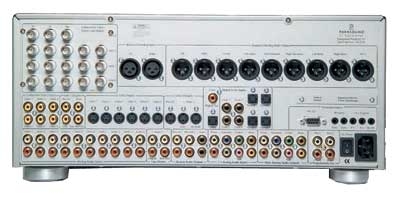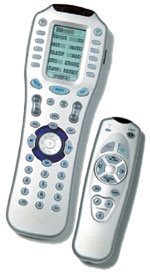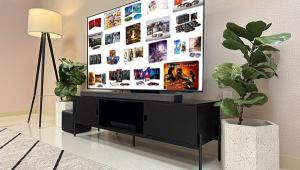Preamps with Star Power Page 4
Parasound Halo C1The most obvious feature of Parasound's Halo C1 sits right up front - its 5-inch, full-color LCD screen, which shows the signal passing through the video section of the preamp. Its most important contribution is during setup, which can be performed entirely using just the front-panel controls and the screen.
|
There's more than meets the eye with those front-panel buttons, by the way. The ones in the bottom row operate like keyboard shift or control keys - you hold one of them down and twist the knob to access and navigate the setup menu.
Among the things you can set up are the fascinating outputs that form Parasound's "7.5-channel" Enhanced Surround system. Two of the outputs are for subwoofers. Both parallel the main sub output, but one of them filters out all the frequencies above 20 Hz and is designed for "floor shakers" or subs capable of delivering ground-pounding bass.
The remaining two auxiliary channels are more interesting. Each can be programmed to deliver a different mix of the decoded 7.1 channels, in any combination and with a user-settable time delay in half-foot and half-millisecond increments - twice as fine as the main distance-compensation settings.
SETUP The Halo C1 is the only preamp in this group that can perform the onerous task of setting speaker balances and distance-compensation signal delays all by itself. Plug in the supplied measurement mike, take your place in the listening position while holding the mike, access the necessary setup menu, "and sit back," says the manual - not because you're going to get blasted, but because your body's proximity to the mike might influence the measurement process.
The results were as good as I could have done manually using a sound-level meter and a yardstick. In fact, given the C1's 1-dB and 1-foot main-channel adjustment increments, it's doubtful that a professional installer could do better. So if you want to roll your own high-end home theater system without outside assistance, the C1 might be your best bet. 
The back panel holds few surprises aside from its very spacious layout, which results in a much taller chassis than on the other two preamps. Its most distinctive feature is the use of twist-lock (bayonet) BNC connectors for the pass-through component-video connections. In a rare refinement, these connectors are of the 75-ohm variety, as is the bag full of RCA-to-BNC adapters Parasound supplies.
The C1 also allows for pass-through connection of computer-type component-video signals (RGB+H/V). But if you feed the preamp video in this format, be sure your TV can display it, since the preamp doesn't perform any conversions between component-video formats. The multichannel analog input is also passed through, except that you can use the volume control. But that also means you can't apply bass management or distance compensation to multichannel analog signals. Just as with the Krell, therefore, you'll hear the correct bass balance for SACDs and DVD-Audio discs only if you either have full-range speakers all around or your player's settings happen to match those that are optimal for your speakers.
 Parasound supplies two remote controls: the elaborate, full-function Halo Master handset, with a backlit LCD screen and buttons, and a smaller, stripped-down SideKick remote, also with backlit buttons. You can use the SideKick after setup to control things like volume adjustment and channel selection, and to select among three presets that can be programmed with macros. You program both remotes via a PC using downloadable software - an operation you can do yourself or leave to an installer.
Parasound supplies two remote controls: the elaborate, full-function Halo Master handset, with a backlit LCD screen and buttons, and a smaller, stripped-down SideKick remote, also with backlit buttons. You can use the SideKick after setup to control things like volume adjustment and channel selection, and to select among three presets that can be programmed with macros. You program both remotes via a PC using downloadable software - an operation you can do yourself or leave to an installer.
PERFORMANCE The C1 sounded like the other two preamps when set to the same surround mode, but it can easily be made to sound very different - and often better in terms of the spatial distribution of sound - by using those two programmable auxiliary outputs. I only had time to verify that a couple of the Parasound "recipes" worked as claimed, but I have no doubt that the others covered in the manual will also work.
One recipe generated signals for two additional subwoofers using bass from only the left and right surround and back channels. Having "stereo" bass coming from the sides of the listening room created an Imax-like immersion, especially with bass-intensive action sequences like those in Spider-Man . With another recipe, using a mix of front and surround channels, I obtained two "extra" surround channels that I used to drive side speakers halfway between the L/R surrounds and the front speakers. This often produced more realistic envelopment (by linking the ambience from the fronts with that of the surrounds) in multichannel orchestral music like the San Francisco Symphony's Mahler series on SACD or Elgar's Third Symphony on DVD-Audio.
These programmable auxiliary outputs might be just the thing for a really big listening room with more than just six satellites and one subwoofer available. Setup and adjustment of so many channels can become tedious, but if you're willing to experiment, or have an installer experiment for you, Parasound's recipes for Enhanced Surround will definitely repay the effort.
The Halo C1 displays an extraordinary attention to detail (those 75-ohm BNC connectors) as well as a couple of surprising oversights (no bass management or distance compensation for the multichannel analog input). It deserves consideration for a large home theater by virtue of those programmable outputs, which have the potential to produce a sonic experience unmatchable by the other two preamps here or by most other equipment of any kind. PDF: Features PDF: In the Lab
The Bottom LineIn an ideal world I'd be able to pick the jewels individually. From Anthem, I'd take the multichannel bass management and distance compensation, the bass-resonance filter, and the rear-panel paint job. From Parasound, I'd take the auxiliary multichannel outputs (several more of them, in fact), the front-panel display, and the button/knob control system, as well as both large and small remote controls and the automatic calibration. As for the Showcase, I can't wait to see what gems Krell comes up with when it releases the new signal-processing circuitry. At these prices, I'm sure they'll be brilliant and well polished. But when each preamp is judged on its merits and value for its price, the Anthem AVM 30 is irresistible.













































